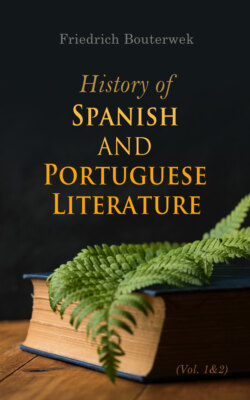Читать книгу History of Spanish and Portuguese Literature (Vol. 1&2) - Friedrich Bouterwek - Страница 15
На сайте Литреса книга снята с продажи.
EARLY CULTIVATION OF CASTILIAN PROSE—DON JUAN MANUEL; HIS CONDE LUCANOR; HIS ROMANCES.
ОглавлениеTable of Contents
But the most valuable monument of the cultivation of Spanish eloquence in the fourteenth century is El Conde Lucanor, a book of moral and political maxims, written by Don Juan Manuel, a Castilian prince. This Don Juan was one of the most distinguished men of his age.35 He was descended, in a collateral line with the reigning family of Castile, from king Ferdinand III. usually called the Saint. He served his sovereign Alphonso XI. with chivalrous fidelity, and by the judicious policy of his conduct, retained the favour of that prince, who certainly had reason to regard him with jealousy. After distinguishing himself by a number of honourable and gallant deeds, Alphonso appointed him governor (adelantado mayor) of the country bordering on the Moorish kingdom of Grenada. In this station he became the terror of the hereditary enemy of Castile. He made an irruption into Grenada, and defeated the Moorish king in a great battle. After this brilliant victory, he always acted one of the first parts in the internal troubles of Castile, and during twenty years conducted the war against the Moors. He died in 1362, leaving behind him some of the ripest fruits of his experience in his Count Lucanor. A Spanish book, so full of sound practical good sense, of a character so truly unostentatious, and clothed in a simple, homely, but far from inanimate garb, could scarcely be expected to belong to the fourteenth century. In estimating the merit of this work, it ought also to be recollected, that at the period in which it appeared, the taste for the wild tales of chivalry called romances had begun to prevail. Amadis de Gaul, the prototype of all subsequent knight-errantry romances, had then obtained general circulation. There is, however, in the Count Lucanor, no trace of romantic extravagance, none of the dreaming flights of an irregular imagination; for in every passage of the book the author shews himself a man of the world and an observer of human nature. In the course of his long experience he had formed maxims for the conduct of life which he was desirous of pursuing. He gave to many of these axioms a laconic expression in verse; and, to impress them the more forcibly, invented his Count Lucanor, a prince conscious of too limited an understanding to trust to his own judgment in cases of difficulty. He gives the Count a minister (consejero), whose wisdom fortunately supplies the deficiency of his master’s intellect. When the Count asks advice of his minister, the latter relates a story, or sometimes a fable. The application comes at the close, and the narrative is the commentary of the verse or couplet with which it terminates. In this manner forty-nine moral and political tales are told. They are not of equal merit; but though some are inferior to others, the difference is not great, and they have all the same rhetorical form. Sometimes it is the idea that gives the chief interest, sometimes the execution. Among the versified maxims are the following.
“If you have done something good in little, do it also in great, as the good will never die.”36
“He who advises you to be reserved to your friends, wishes to betray you without witnesses.”37
“Hazard not your wealth on a poor man’s advice.”38
“He who has got a good seat should not leave it.”39
“He who praises you for what you have not, wishes to take from you what you have.”40
This last axiom is deduced from the well-known fable of the fox and the raven. It is curious to observe the resemblance between the unconscious artless simplicity with which Don Juan Manuel relates his fable, and the finely-studied simplicity with which the elegant La Fontaine tells the same story. Who would expect to find in an old Spanish book of the fourteenth century, the same knowledge of the world and mankind, as distinguished the refined age of Louis XIV.41
This work appears to have been preserved without alteration, as it was originally written. It is only occasionally that the difference of the language in single words,42 betrays the officious industry of some transcriber. In a short preface, the author gives a candid explanation of the object of this collection of tales.
Don Juan Manuel was also the author of a Chronicle (Chronica de España); the Book of the Sages, (Libro de los Sabios); a Book of Chivalry, (Libro del Caballero); and several other works in prose of a similar nature.43 It appears that these works are now lost, though they were preserved in manuscript in the sixteenth century. A collection of Don Juan Manuel’s poems also existed at that time, according to the express testimony of Argote y Molina, who published El Conde Lucanor in the sixteenth century, and intended to publish those poems likewise. He calls them coplas; and they certainly were not alexandrines. After this testimony, it can scarcely be doubted that some of the romances and songs, which are attributed, in the Cancionero general, to a Don Juan Manuel, have this prince for their author.44 But if such be the fact, then how many of the similar romances which are still preserved, may, considering the greater antiquity of their form, be yet more ancient!
